“For me, he has not yet made a breakthrough to be an absolute top player” –
Jupp Heynckes (May 2020)
Leroy Sané is undoubtedly the best talent in the world, and everyone knows Bayern is very interested in the Manchester City winger. Born in Essen, Germany, Sané has 134 appearances under Pep Guardiola. It seems that he would be a perfect deal for the Germany club.
However, we should never naively eliminate all the issues of an individual. When speaking of what Sané could offer his new team, answers such as injections of pace and dribbling emerge, but we seldom think of his weaknesses. Instead, as expressed in the above quote from former Bayern manager Heynckes, there were concerns of whether Sané could perform at the highest of standards, like a Lionel Messi, Cristiano Ronaldo or Neymar.
In this tactical analysis, we will analyse the potential issues of Sané at Bayern. This analysis is a scout report focusing on the tactical aspect.
Consistency issue
“he is 22 years old and he can be a little bit up and down at that age.” – Guardiola
Back in 2018, Guardiola pointed out that the German international could be more consistent. You may think, as time has passed, Sané should have gained enough experience to develop into a stable player. However, we can assure you that this is not the case, as, in 2019, the young winger has totally lost his place under the competition from Bernardo Silva and Raheem Sterling. He was given a chance to show his quality in the Community Shield, however, he was injured during that game and has remained unavailable since then.
Despite having some wonderful moments at Schalke 04 as a right-winger, Sané almost never plays on the right at City. Mainly because it would present a complex issue that mingles the limitations of the player and the team’s tactics. Therefore, Sané played as a left-winger, having a good partnership with David Silva on this flank.
With the use of data, we tried to measure the performance of Sané in different situations. The following three metrics: crossing, dribbles and progressive runs were adopted on a 90-minute basis.
| Stats per 90 mins | Crossing (%) | Dribbles (%) |
Progressive runs |
|
Winning and drawing (2659 mins) |
3.68 (29.38%) | 7.14 (49.76%) |
2.23 |
| Losing (223 mins) | 5.24 (8%) | 14.13 (59.14%) |
2.02 |
If Sané was going to Bayern for a high transfer fee, we would expect him to show his quality and help his team when they were losing. When City was losing, Sané delivered more crosses (5.24) but the completion rate was very low (8%). It is conceivable that City was trying to break the low block under these circumstances, but the sharp decrease of 21.38% crossing accuracy hints that Sané could have performed better.
In terms of dribbling, Sané was better when the stats were projected into a 90-minute basis(14.13–7.14), as well as a higher success rate (59.14%-49.76%). However, these dribbles might not be conducive to ball progression, as the German winger had a higher progressive run number when his team was winning or drawing (2.23–2.02).
Apart from comparing numbers in different situations, we also show you the consistency of Sané’s performance through the broken-line graph. It was common knowledge that the winger possessed pace and physical superiority which make his dribbling so good, but a key question is: can he maintain the standard?
We used games that Sané played more than 45 minutes as a reference, there were 31 games. As shown in this graph, the quality of his dribbles fluctuated throughout the season. There were some highlights, such as the home and away games against Hoffenheim but as shaded in the graph, the same performance might not occur in the next game. He attempted 15 dribbles in the home game against Hoffenheim (game 14) but completed none of them in the previous game (game 14: Chelsea away). When returning to the Premier League (game 15), there was only one successful dribble recorded.
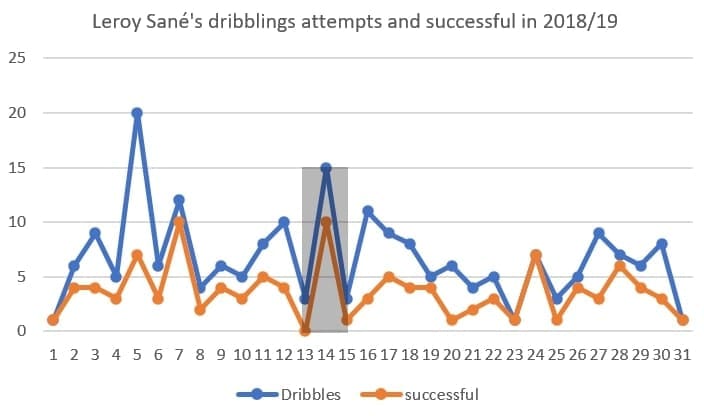
In the second line-graph, we showed his crossing stats by obtaining data from the games that Sané played more than 45 minutes. Again, in terms of the number of crosses, Sané’s contribution fluctuated throughout the season. We should specifically notice that in game 16, where Sané tried nine crosses but none of them succeeded, was directly after the 2-3 home loss against Crystal Palace. This could be a hint that Sané might struggle to deliver something special when his team is losing because of reasons relating to mentality and tactics.
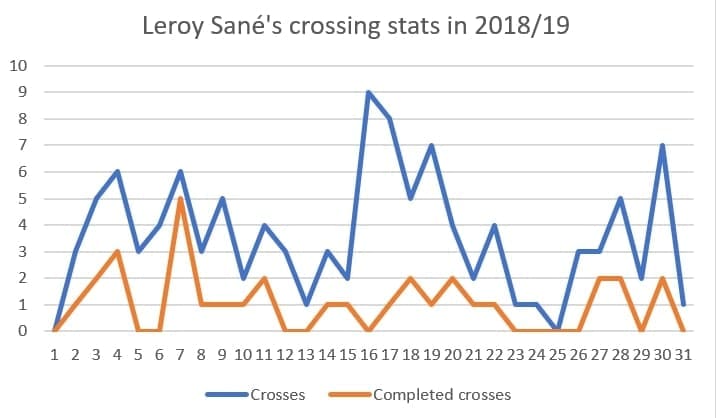
So, how does this issue affect the game? Firstly, we should understand the strengths and secrets of Sané’s dribbling skill. The German winger does not rely on techniques and skills such as stepovers and the ‘elastico’. What makes him special was his gifted physical qualities from his parents, who were both athletes. With his exceptional body softness, coordination, elasticity, agility, and balance, Sané is always quicker than his opponents, this unpredictability and physical qualities help him beat opponents in 1v 1 situations.
However, when he has lacked match fitness due to playing through injuries, this strength could not be utilised to create the dynamics in perfect timing. The below image is a situation that Sané always faced whenever he tried to cut inside. Sané’s technique on his right foot is weak and this certainly makes him predictable in these cases.
When he was fit, as mentioned, he always shifts the ball to his left side after using footsteps to shake the opponents off-balance. However, when Sané was carrying pre-existing injuries, he could not seize the moment to get past his opponent with the same set of moves. This constrained the potential to create dynamics in the final 3rd, as the defenders were well-prepared to deny Sané.
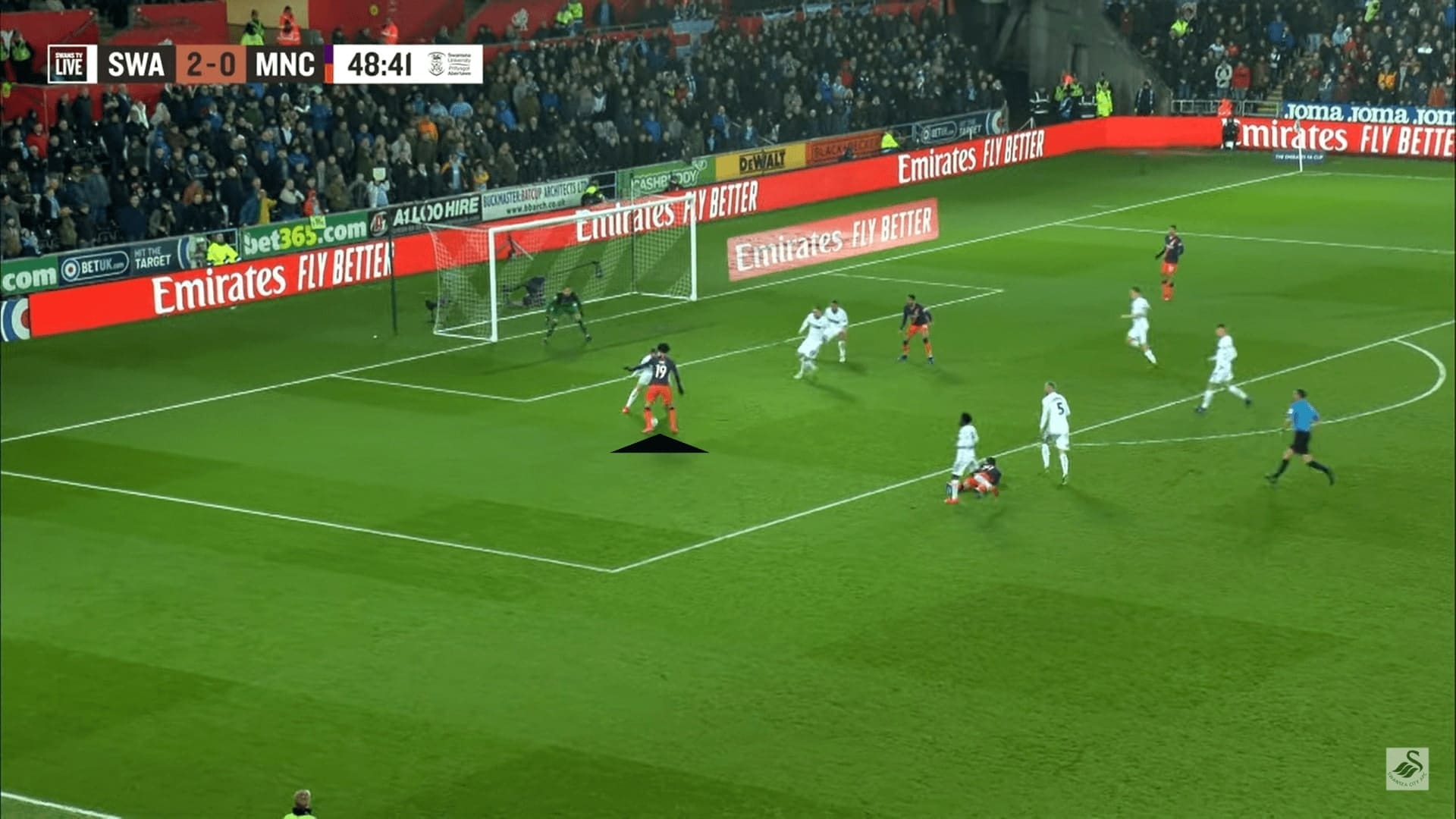
Shooting and finishing
Sané scored 16 goals out of the xG 8.92 in the 2018/19 campaign amazingly, which shows his effectiveness and clinical finishing in front of the goal. However, what he needs is to produce goals at the same rate in multiple seasons. In addition, there was still room for improvement in the shooting and finishing domain, when we consider his potential switch to Bayern.
The below graph summarises the positions of all 107 shots from Sané. A very large proportion of his shots (41.1%) occurred in zone D, also known as the assist zone. Another one-fifth (20.6%) came from zone G, which was outside of the penalty box. There are several reasons that constitute the formation of this graph, and, apparently playing as the left-winger allows Sané to get the ball in these zones very often.
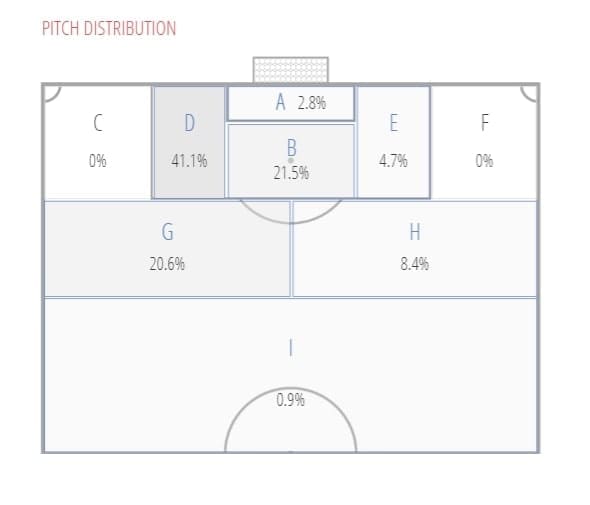
Another reason was the setup of City, in which Guardiola played Bernardo Silva or Riyad Mahrez as the right-winger. Both players naturally cut inside with their left-foots and deliver the ball towards the far post with an in-swinging cross. In these cases, Sané always asks for the ball at the far post, usually behind the last defender. All the German winger had to do was to attack the goal simply by meeting the pinpoint cross. This was how he scored the goal at Vicarage Road with his chest as shown in this image.
However, at Bayern, the same service is not guaranteed because of the differences in personnel. Currently, Hans-Dieter Flick assigned his left-footed Ivan Perišić to the left flank, so we must assume Sané would play on this flank too. The remaining options on the right flank might be Serge Gnabry and Thomas Müller, who would not offer the same service since they are right-footed players.
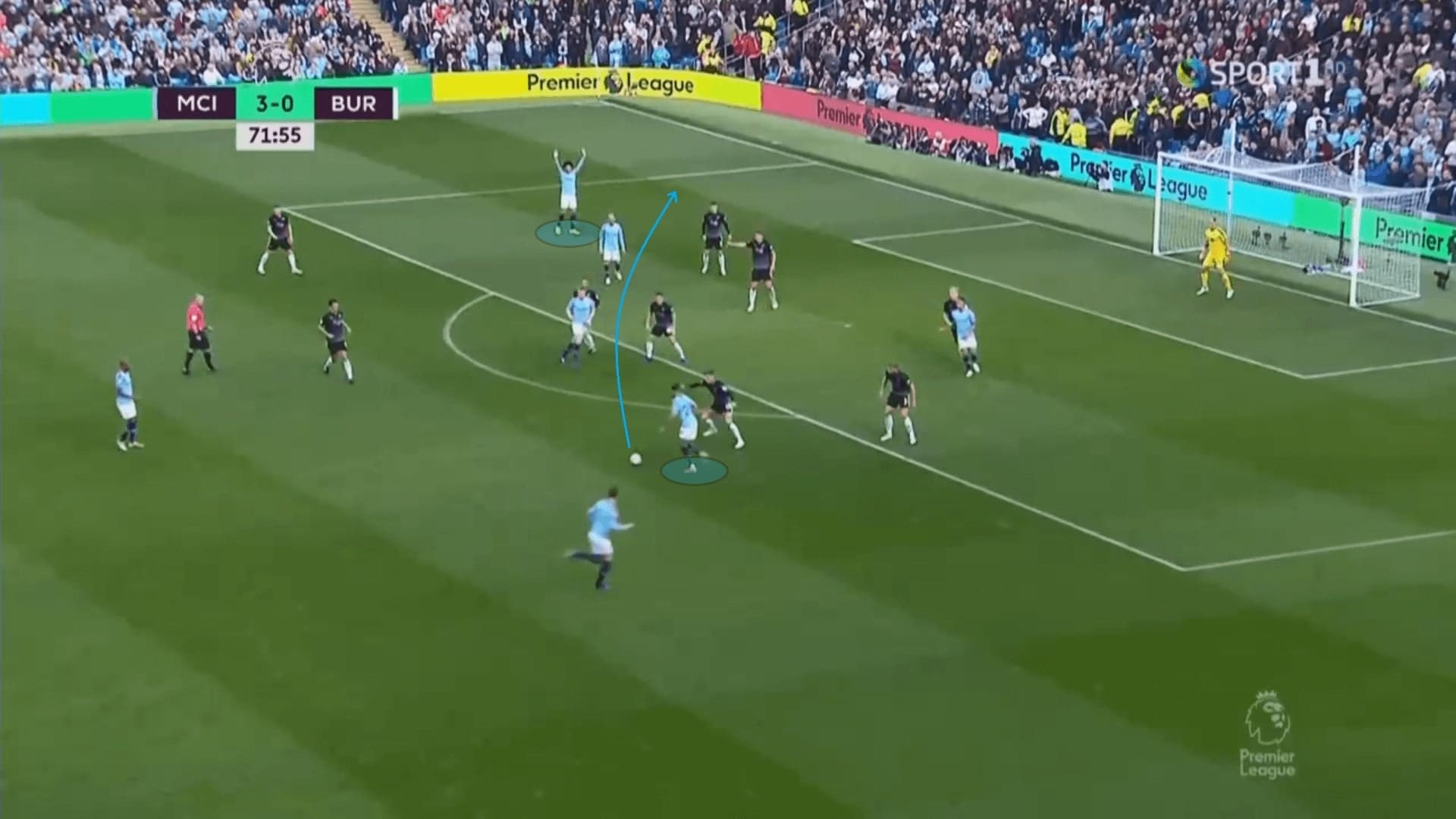
As mentioned, Sané always tries to shoot in the assist zone. Sometimes you would feel that it was a suboptimal decision and hence, unnecessary. This is often the case when his team need a goal, and Sané rather shoots even if players are in front of him. These situations occur partly as a result of his inability to drift inside and use his right foot to shoot as explained previously.
In this image, you could see Sané still takes a shot despite the two Swansea players positioned in front of him. Unsurprisingly, the shot was blocked by the defenders. In fact, it was needless to shoot in this zone, as the btter option was to circulate the ball and exploit spaces in other areas.
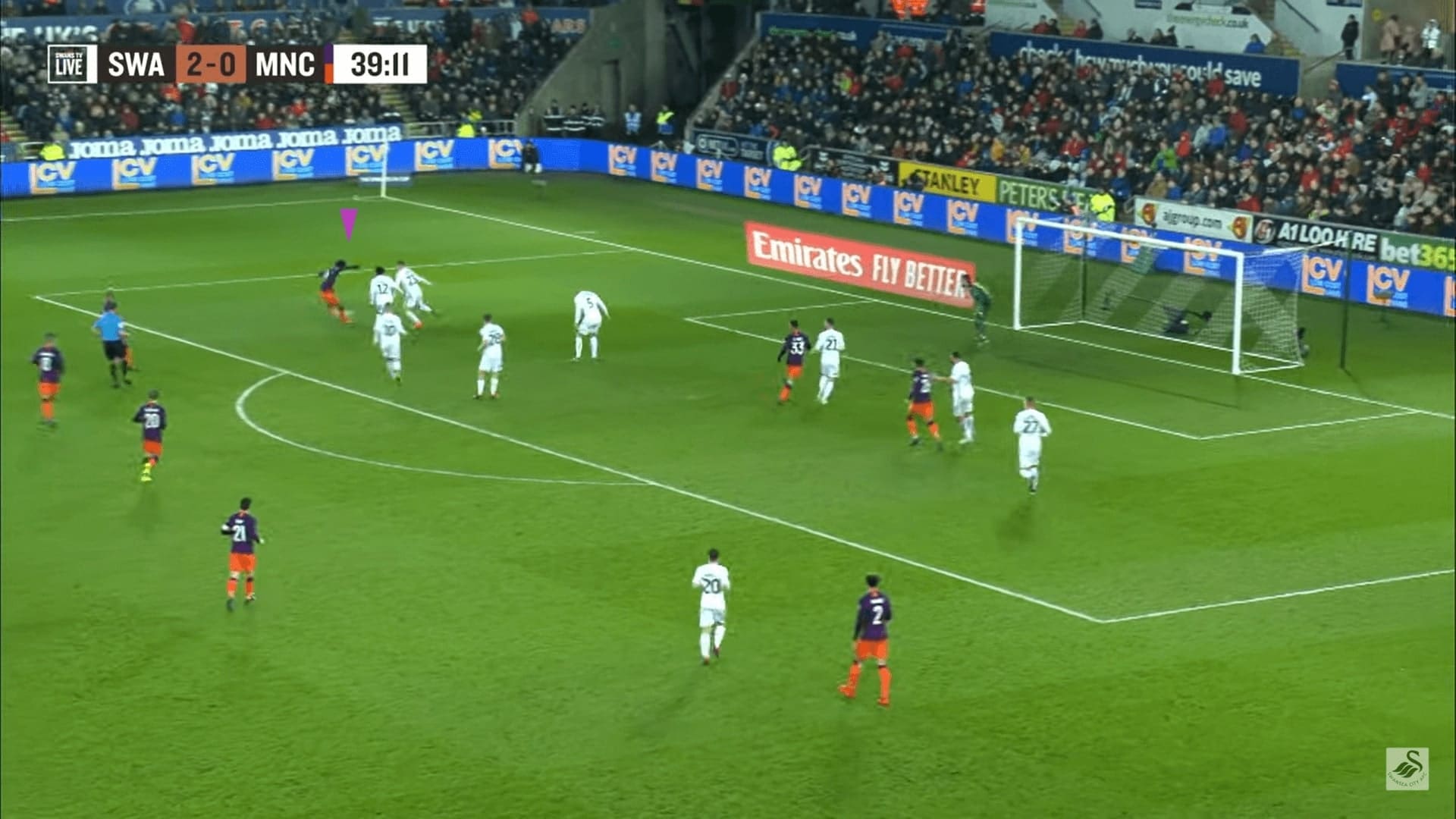
What Sané would possibly do at Bayern is attempt shots in the golden zone or zone 14. Therefore, he has to work on his body orientations and right foot to finish those chances. These situations would be similar to the one in the below image, as he was coming from the left flank to receive the cross from the right-footed player. In these cases, the player should try to use his right foot to shoot because of the travelling angle of the ball. Using the right foot helped him to generate more power and control the direction of the ball better before the opponents arrived. We would expect to see Gnabry, Müller and Benjamin Pavard provide these crosses at Bayern, and this is the reason that Sané has to learn to use his right foot.
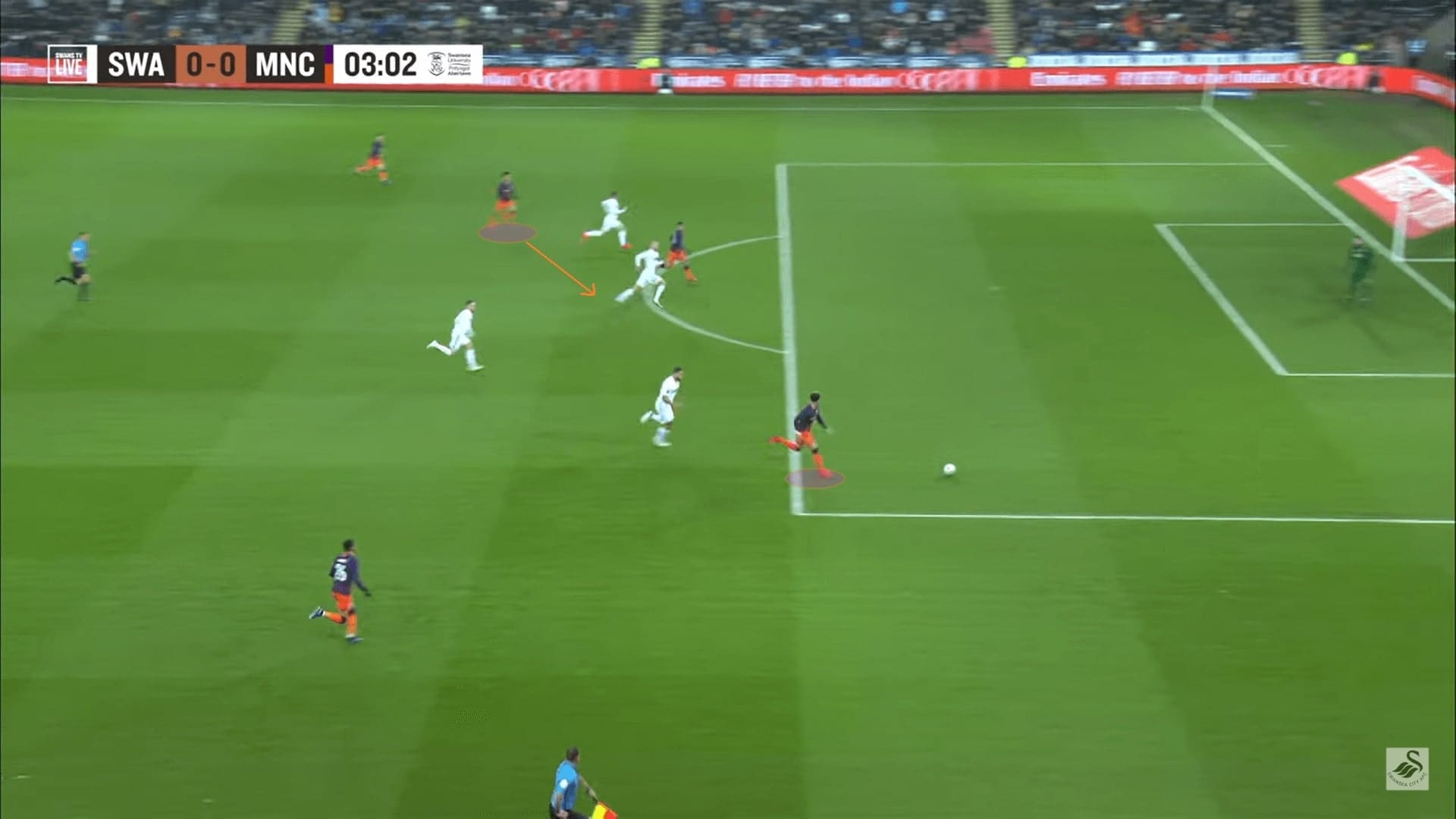
Defensive contributions
In general, we should not expect too an offensive winger like Sané to defend that much, not everyone is B. Silva. However, in the modern game, not many teams survive without pressing, so assuring all the players are on the same page is vital in the defensive phase, unless your Lionel Messi. What concerned us was that the action of Sané at a collective level could become the weaklink in Bayern’s defensive system. This could be nullified when playing against Bundesliga teams, but neglecting this might cost them hugely during the big games in the UEFA Champions League.
The first thing we would like to point out is a mingle of attitude and tactics. During possession turnover, it is common to see Sané complaining or moaning and stood still. Apart from the adverse impact on the team atmosphere, a bigger problem is that this would miss the counter-pressing opportunity! This could be an issue, especially when playing at teams such as Bayern and City, who set high defensive line and relied on counter-pressing to ease the burden of the defence.
In this example, Sané gave away the ball because of a sloppy pass to the centre. His instant reaction was not trying to amend his error but standing and looking at his left-back. In this case, undoubtedly, he should counter-press and cover spaces behind Oleksandr Zinchenko. Fortunately, Burnley did not find the optimal free player in the transitions because of the counter-press from Kevin De Bruyne and Fernandinho.
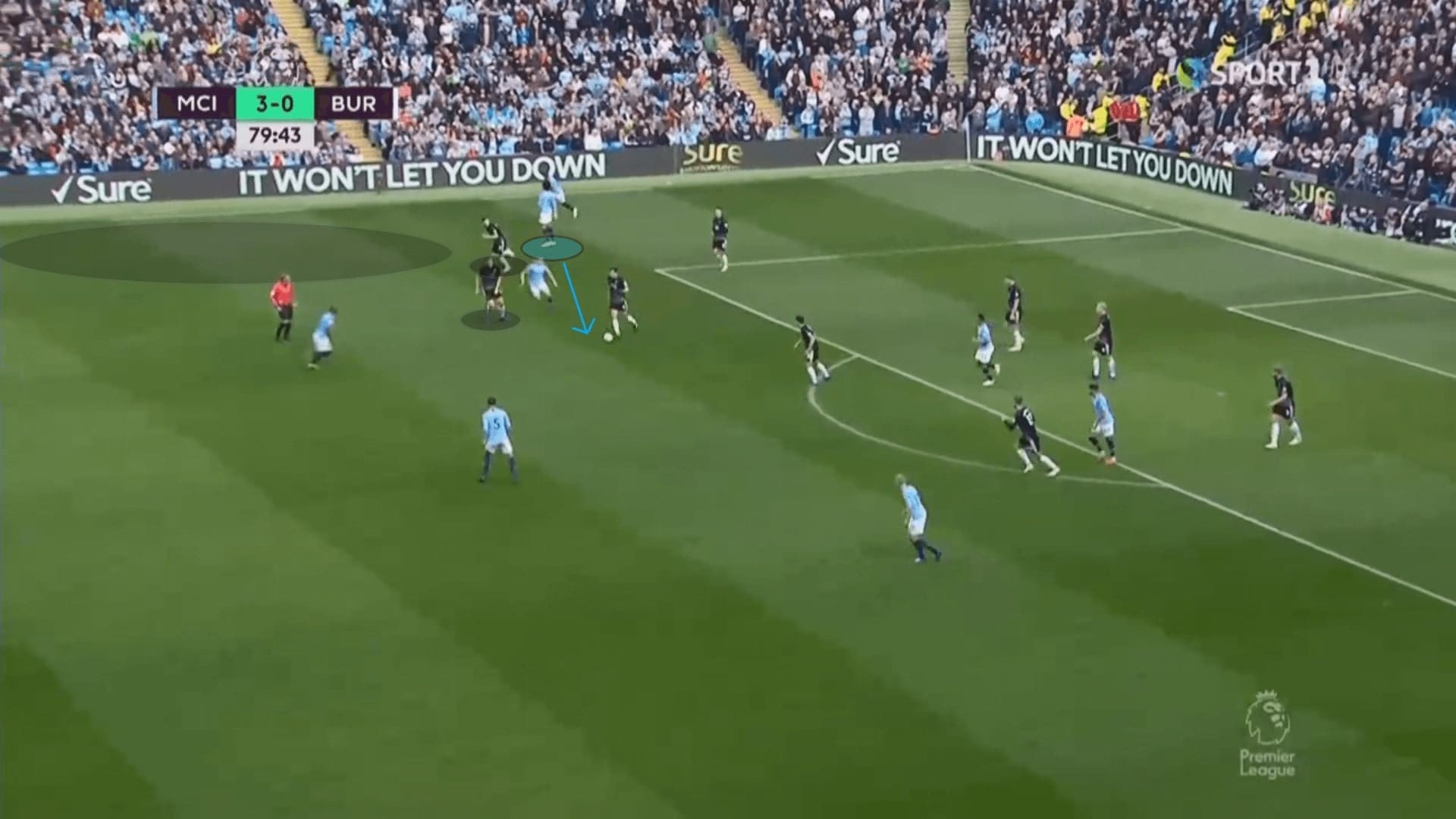
Although Sané possesses electric pace, he prefers to spend his energy when attacking. When defending, Sané could do more by springing while there’s compressed spaces in a counter-press. If not, he should track the free player to make the counter-press successful. However, the defensive awareness and commitment of the German winger is a bit below par, this explains why he previously lost his place in the team.
Taking the below image as an example, in which Zinchenko stepped out to engage the ball. Sané was at the blindside of the ball carrier, which gave him a slight advantage to steal the ball. Or, conservatively, Sané could have covered spaces behind the left-back to deny the counter-attack. However, Sané was too slow to approach the ball, hence, allowing West Ham to escape from the counter-press by finding the free runner (red arrow).
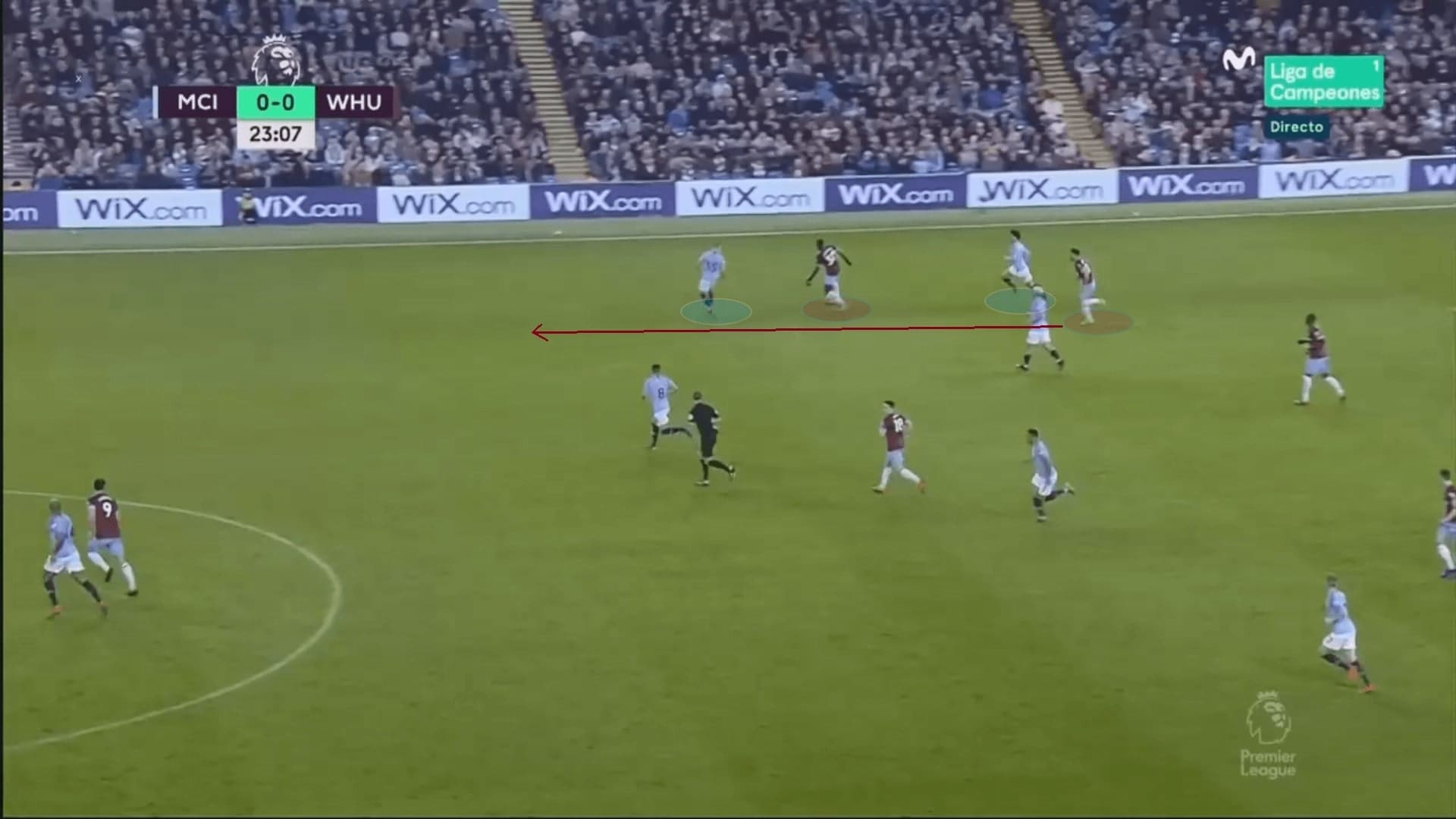
In some moments, you question Sané’s concentration level in a game. It seems that he was not fully paying attention to his surroundings when his team did not have the ball. This was potentially exploited by the opponents to develop the attack. We have some examples to illustrate this issue.
In the below image, Swansea were playing a throw-in deep. City were man-marking players on the flank, Sané was tasked to mark George Byers (No. 28). However, as you can see from the German international’s body shape, he checked his surroundings while forgetting the presence of Byers. His target could escape from the marking and drop into space easily.
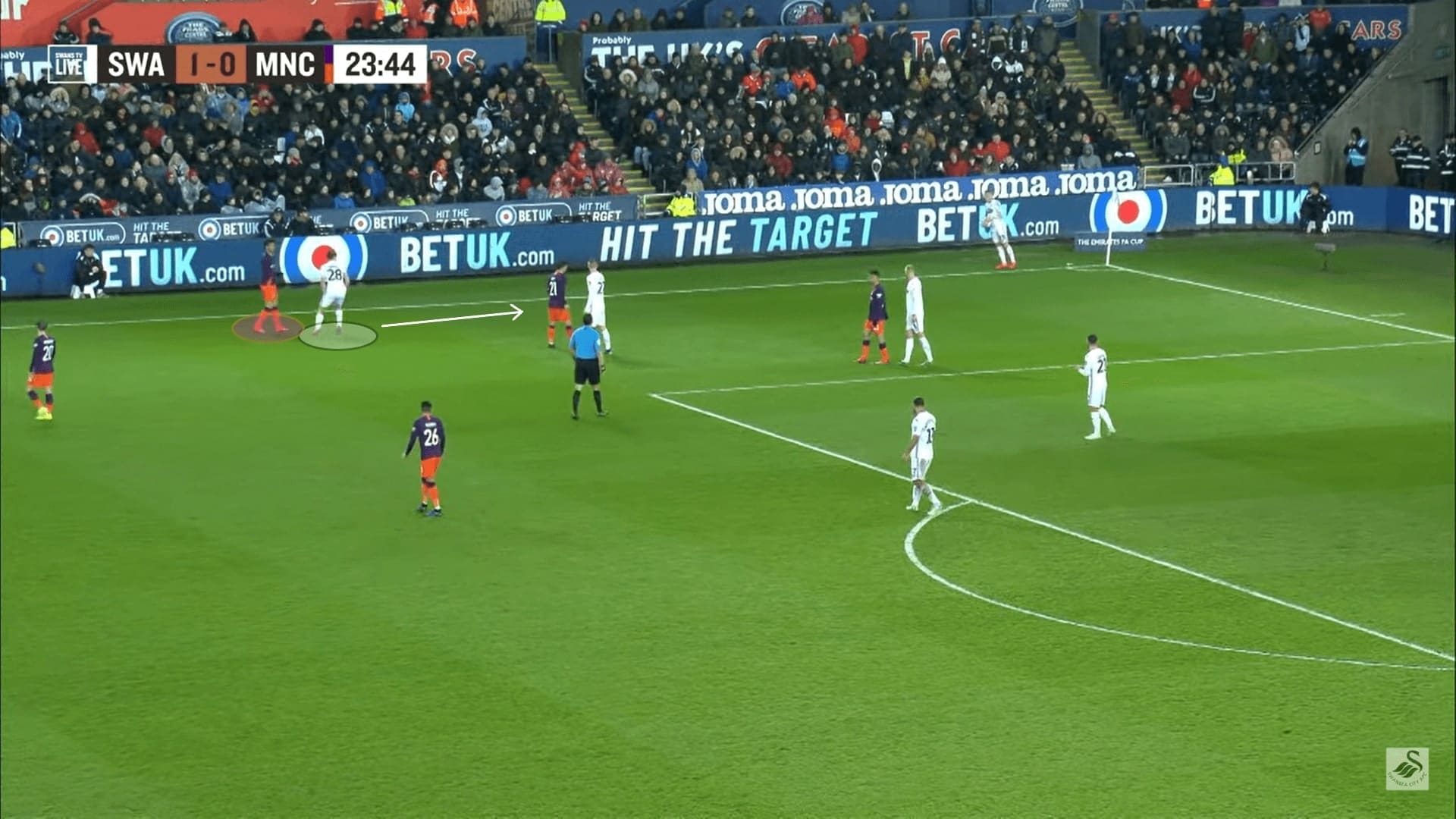
In the second example, the ball was bouncing towards Sané slowly. In these cases, we would expect the left-winger to show more desire to attack the ball, instead of waiting for its arrival passively. If Sané had dashed forward to fight for the ball, he was quick enough to take it before the opponent arrived. In reality, he did not, and gave away the ball.
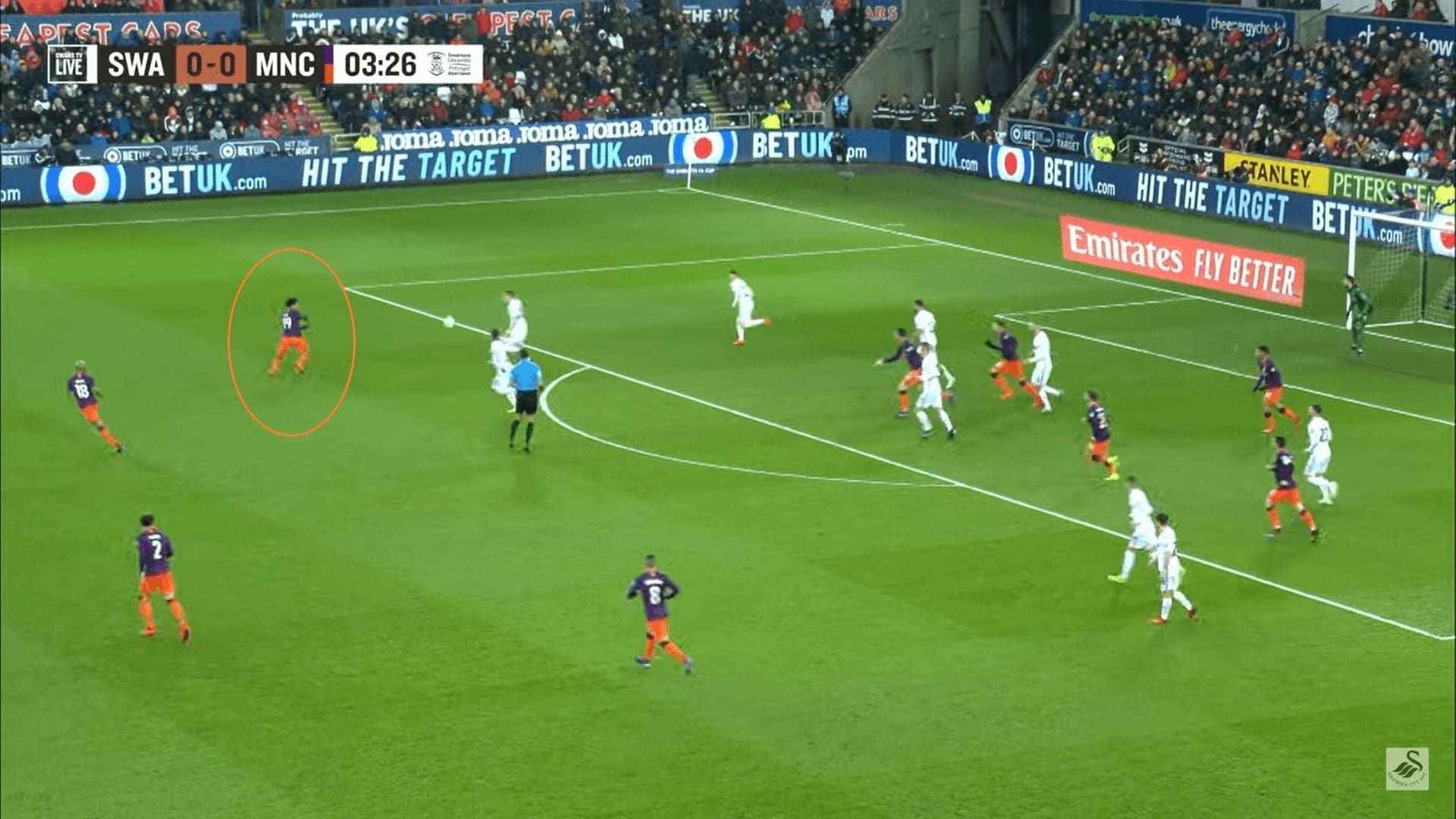
The last case we show is a scenario at Stamford Bridge. Again, we have to stress that we should not expect Sané to play like Bernardo Silva, covering every blade of grass. However, at least he should show the desire to defend and help his teammates from a collective aspect. His laziness and ignorance when defending allowed N’Golo Kanté to score the opener.
In this scenario, Eden Hazard drifted into the penalty box and drew everyone’s attention. We highlighted the positions of Sané and Kanté respectively.
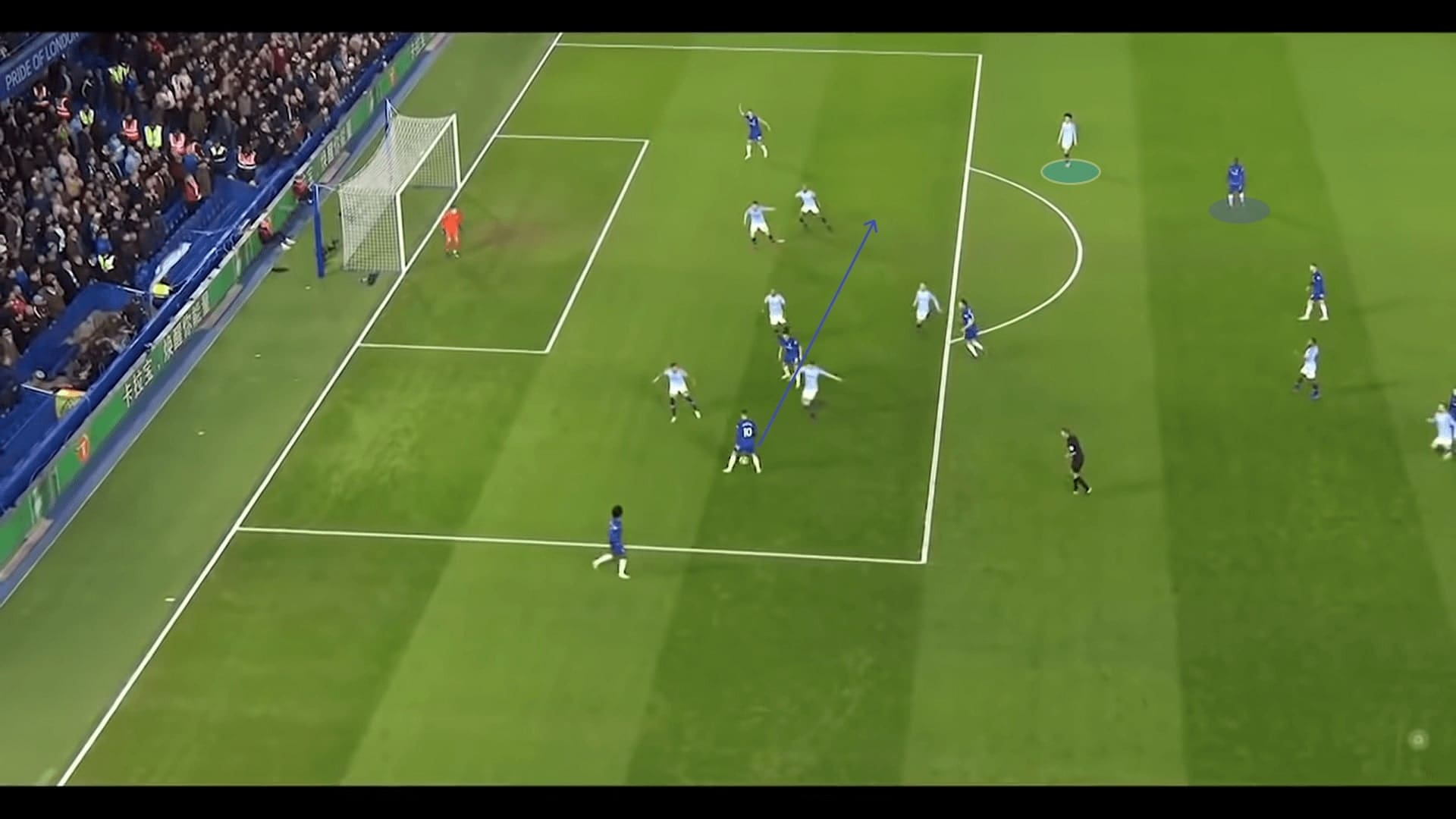
When Hazard crossed, despite coming from a farther position, Kanté managed to reach the ball first. This is because of the ignorance of Sané to defend spaces and keep his eyes on the pitch. We can’t know for sure if this is an attitude issue or a defensive awareness issue.
Again, in the Bundesliga, these situations might be fine as Bayern has the qualities to deal with German teams. But who knows whether the similar situations would cost them goals in the UEFA Champions League again or not?
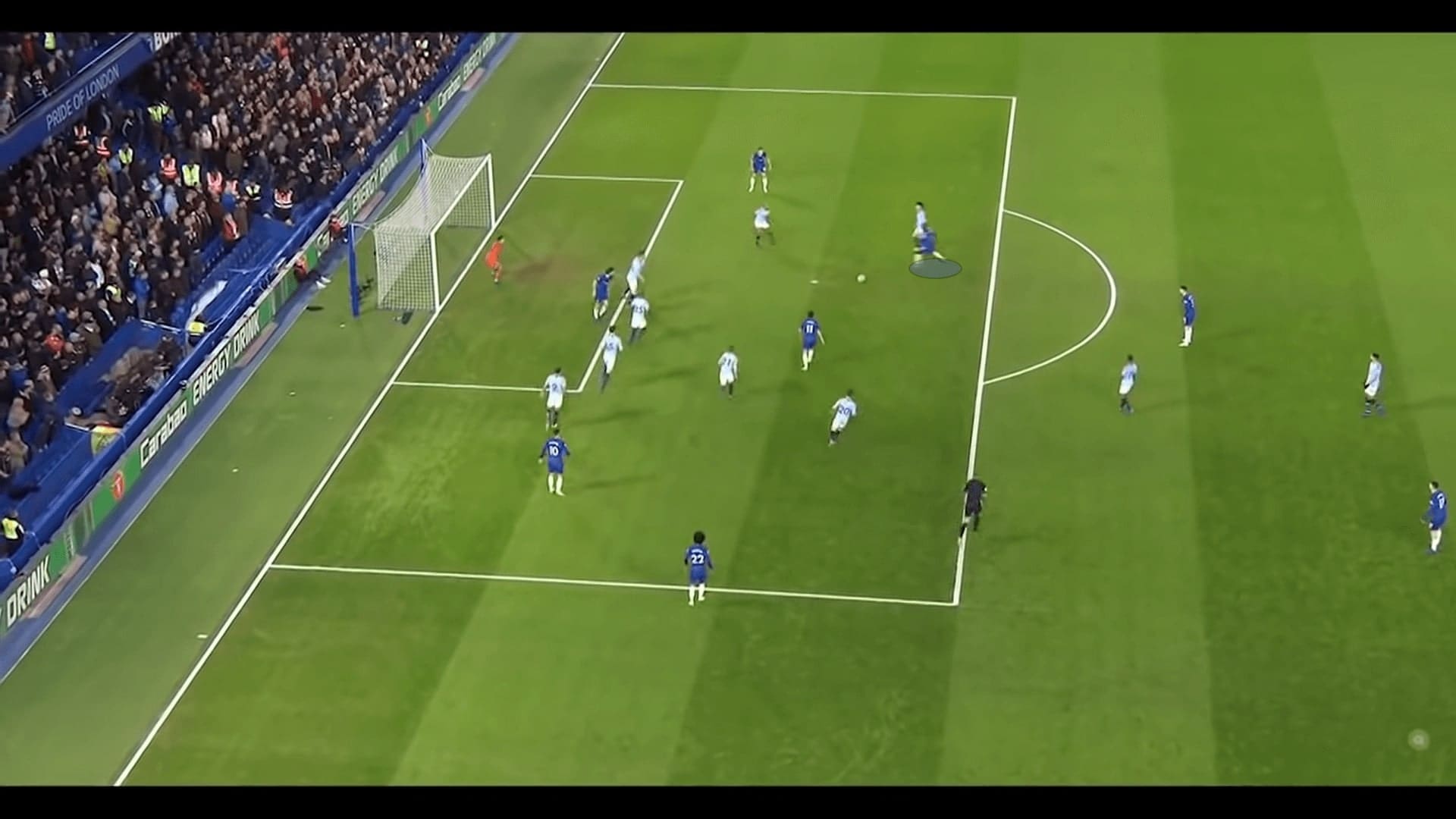
He has to show the versatility and maturity
In the last section of our scout report, we explain the huge differences between the setups and personnel at City and Bayern. It is vital to understand that under Guardiola’s tactics, Sané’s job was not complicated. Though Bayern’s attacks also put emphasisis on positional plays, the approach might be less favourable for Sané when comparing to City’s.
At City, Sané mainly attacks with David Silva and the left-back, these three occupy the left corridor and the left half-spaces. He is going to receive the ball in the following conditions: a pass from centre-back; released by David Silva; found by the left-back; switch of plays. With Aymeric Laporte’s exceptional passing ability, when the left-back and D. Silva tuck into the half-spaces, the passing lane to Sané is opened.
The image below shows the distribution of players on the flank, no three players occupying the same vertical zone at the same time, in this case, Sané stayed wide.
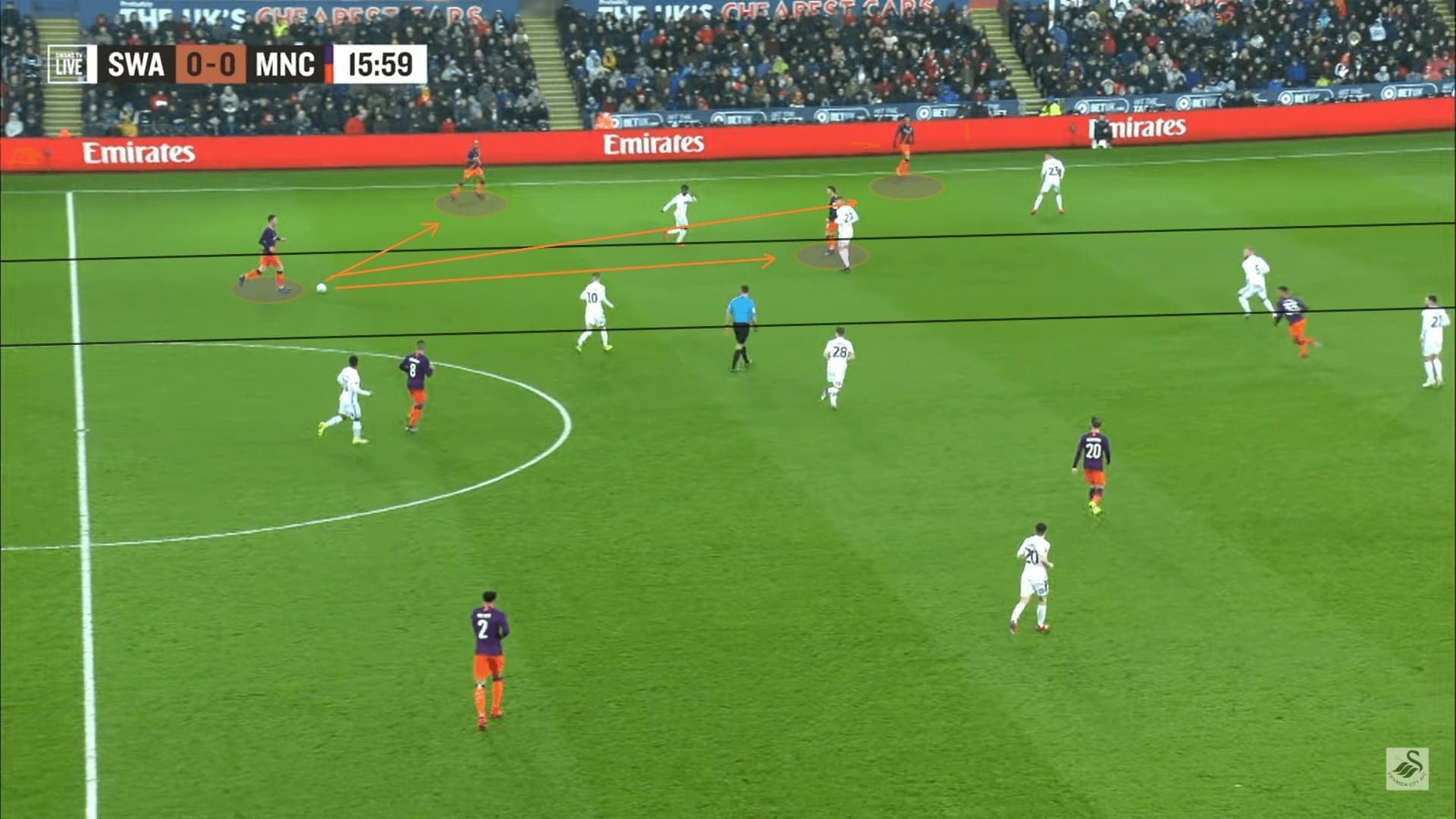
When receiving the ball out wide, Sané has plenty of options which are visible and simple to execute. David Silva ran into the half-space, the left-back also provided supporting runs depending on the situations. The job of Sané was to find them, as indicated in the below image. The German international was given spaces, even David Silva was unavailable initially, Sané could have exercisedhis dribbling to draw the defender while opening the passing lane; or, drifting to the byline and crossing.
However, it would be questionable whether Flick could arrange this comfortable setup for Sané. Bayern often play with two midfielders deep, such as the combination of Joshua Kimmich and Thiago or Kimmich and Leon Goretzka in recent games. That means the supporting runs in the half-spaces are not guaranteed if Sané stays wide. He would have to learn to create and exploit the dynamics, the responsibility would be heavier while the task would be more difficult.
Another potential issue that Sané needs to adapt when playing as the left-winger is his positioning. At City, he was free to stay wide when playing with Zinchenko and Fabian Delph. At Bayern, he might need to accommodate with Alphonso Davies, an offensive left-back. That means each of them will occupy one vertical zone on the left. The chemistry and understandings between these two would be decisive on how quickly Sané could fit in at Bayern tactically.
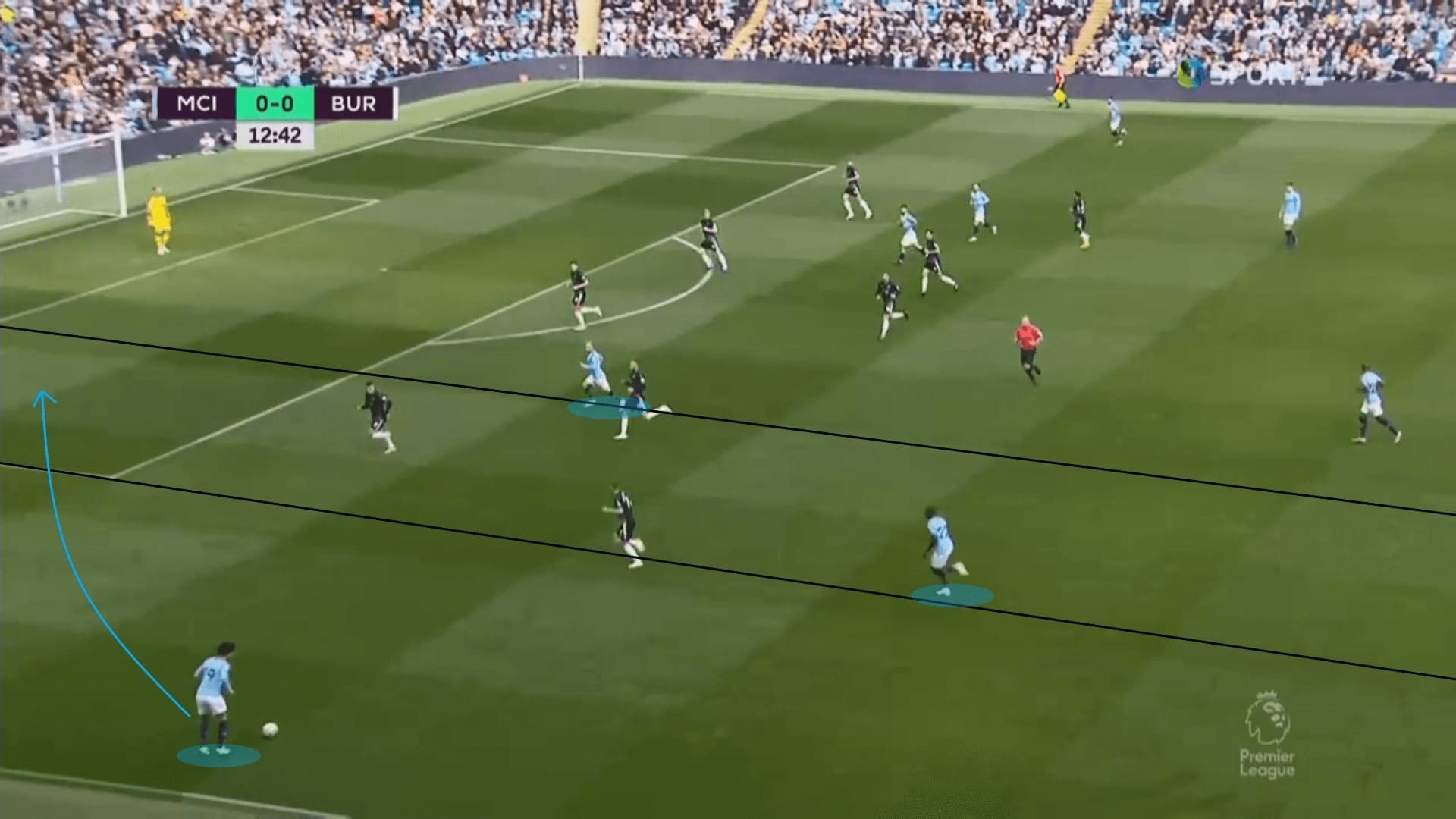
In the 2018/19 season, Sané produced 4.04 crosses per Premier League game, the highest among all City wingers. A big factor to allow Sané’s regular crossing on the left is David Silva. As a left-footed player, the Spanish midfielder is very comfortable to play the release ball to Sané. The left-winger, who stayed wide initially, is free from the right-back’s marking as David Silva absorbs pressure for him. As a result, in the below image, Sané has room to cross.
However, at Bayern, Sané is very unlikely to receive the same services. Neither Thiago nor Kimmich are left-footed player; when Müller was playing as the top of the midfield triangle, he tended to operate on the right. This means the possibilities to replicate and enjoy the same service is smaller. It would be interesting to see how Sané develops and fully utilises his strengths on the left flank.
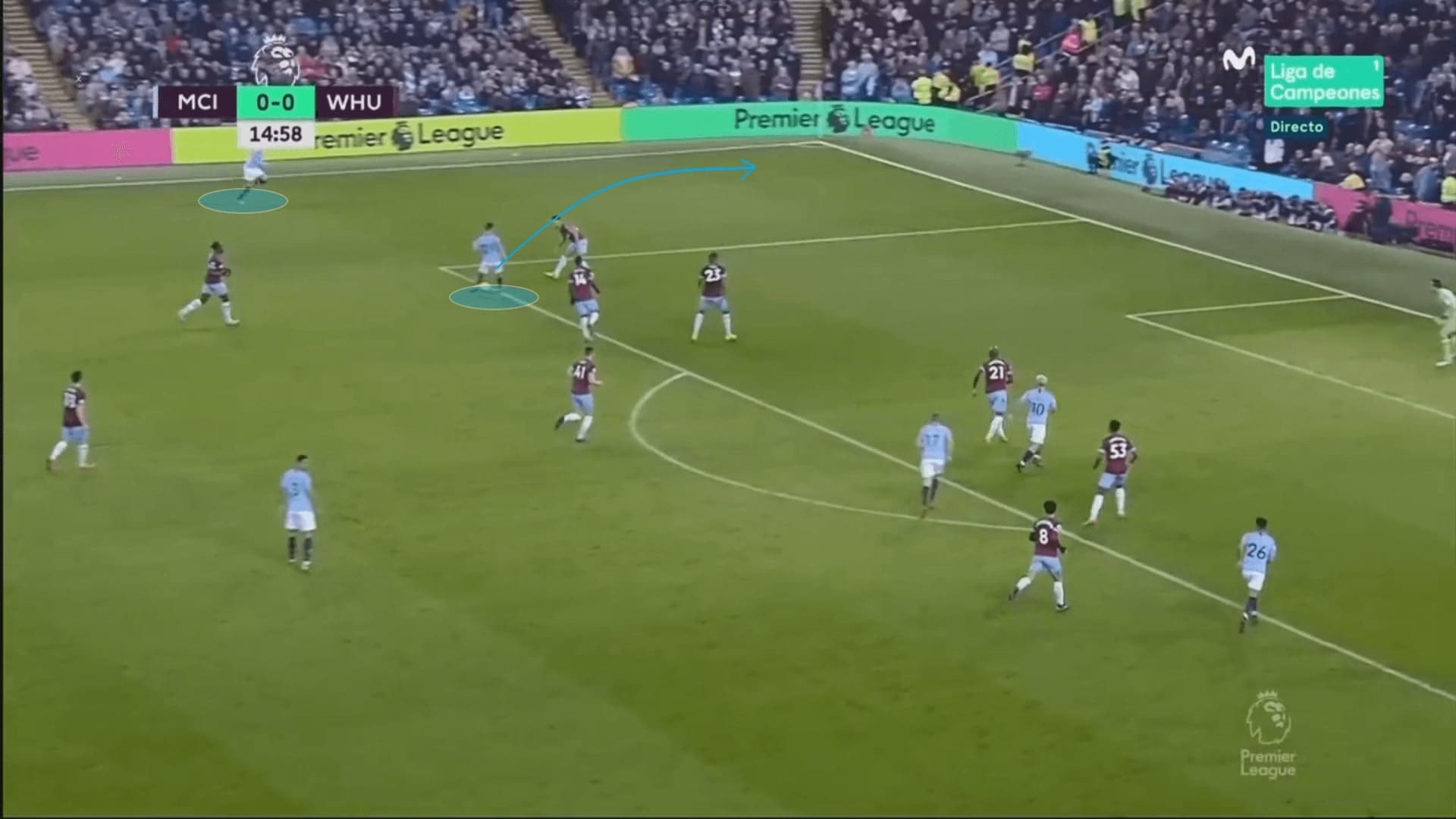
Final remarks
We have to stress that Sané’s talent and potential is undoubtedly the best in the world. However, what we are trying to point out in this analysis is the barriers and details that separate him from the world-class players. There are mainly two ways for him to achive this: to upgrade his offensive ability to Messi, C. Ronaldo, and Neymar’s level, so the coach is willing to sacrifice his defensive duties. Or, alternatively, to try to ameliorate the above domains, which should help him to fit at Bayern easier.
To conclude, the issues of Sané cover the individual and collective domains. Individually, he could create better dynamics by developing his right foot. Meanwhile, since football is a sport that also requires collective behaviour, Sané should place the team responsibility higher than his performances. Despite all the expectations on him, let’s not eliminate the possibilities of his potentially difficult period when adapting to the new tactics at Bayern.


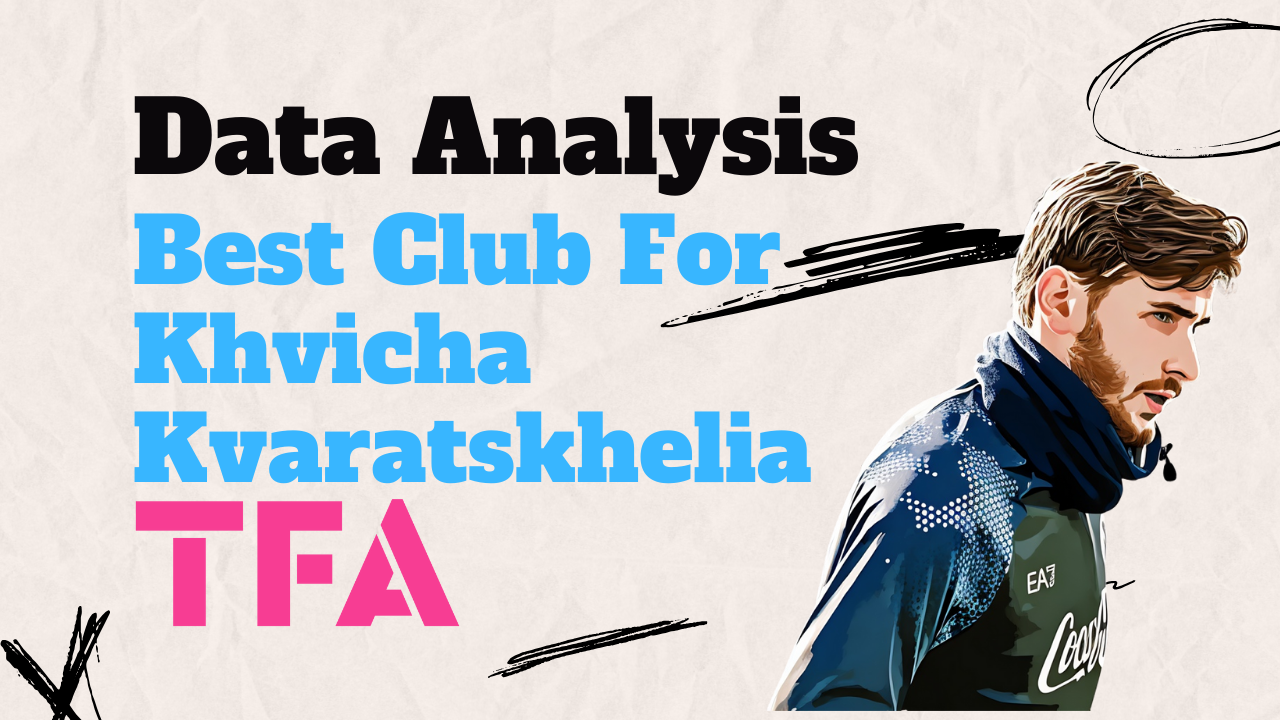
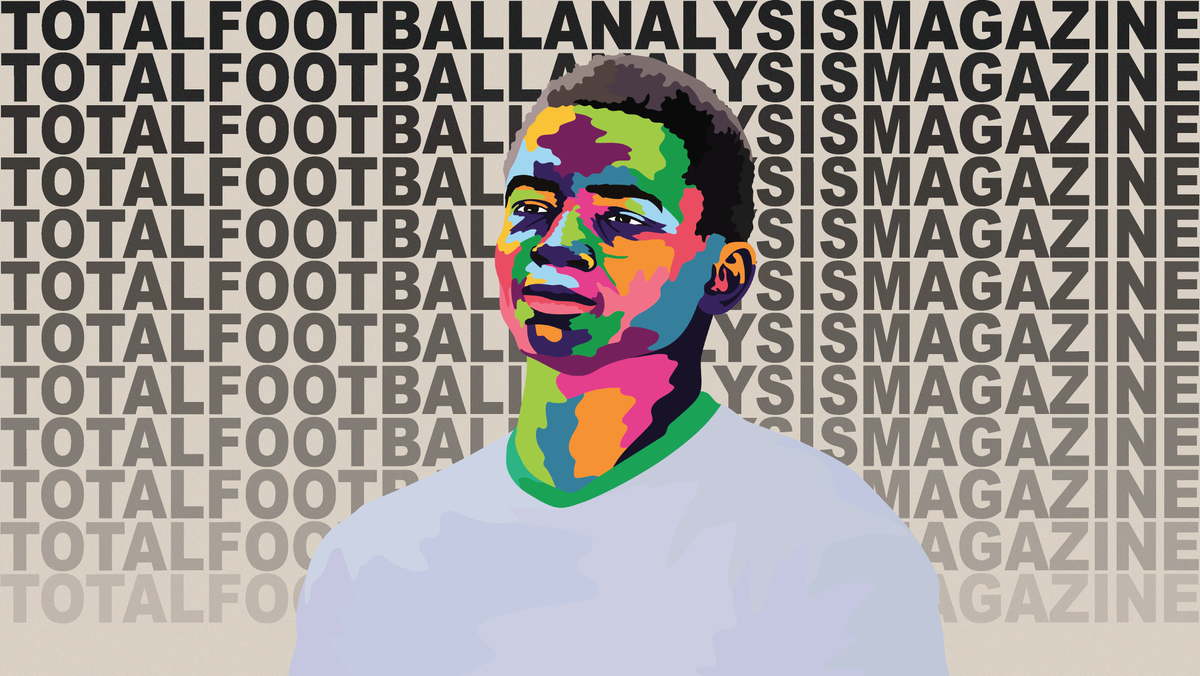

Comments